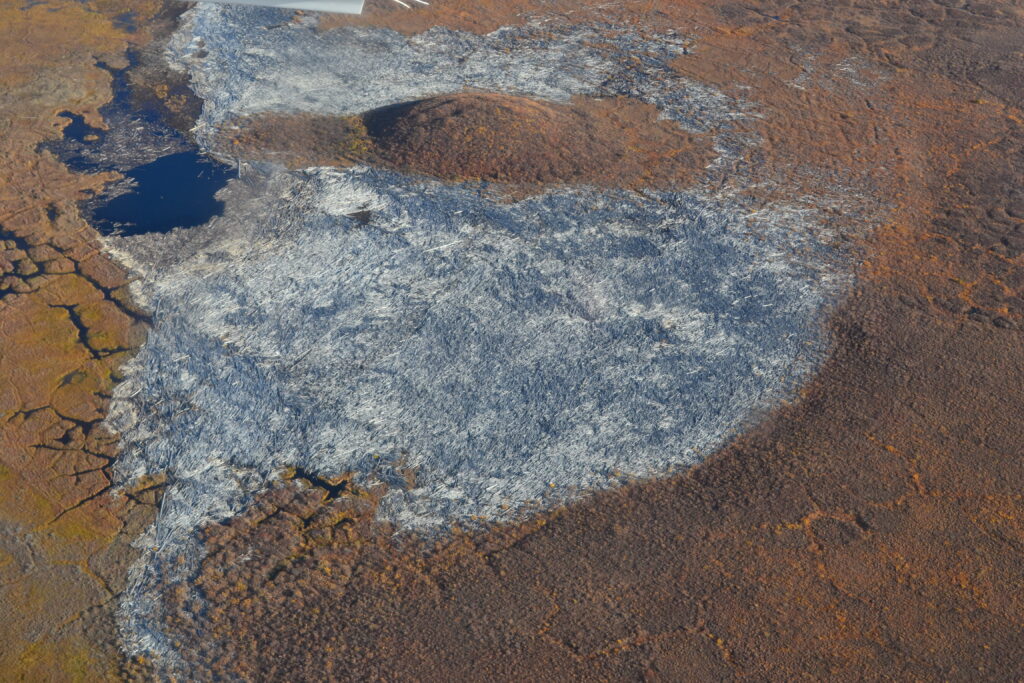WASHINGTON — Throughout the Arctic, fallen trees make their way from forests to the ocean by way of rivers. Those logs can stack up as the river twists and turns, resulting in long-term carbon storage. A new study released by the American Geophysical Union has mapped the largest known woody deposit, covering 51 square kilometers (20 square miles) of the Mackenzie River Delta in Nunavut, Canada, and calculated that the logs store about 3.4 million tons (about 3.1 million metric tons) of carbon.
“To put that in perspective, that’s about two and a half million car emissions for a year,” said Alicia Sendrowski, a research engineer who led the study while at Colorado State University. “That’s a sizeable amount of carbon,” she said, but it’s not a carbon pool we know much about. “We have great knowledge about carbon in other forms, like dissolved or particulate organic carbon, but not what we call ‘large carbon’ — large wood.” That’s starting to change.
Scientists have known for decades that driftwood can really get around in the Arctic, but they are just beginning to quantify how much wood there is and how much of its carbon storage we risk losing to climate change. The Arctic’s cold, often dry or icy conditions mean trees can be preserved for tens of thousands of years; a tree that fell a thousand years ago might look just as fresh as one that fell last winter, Ms. Sendrowski said.
“There’s been a lot of work on fluxes of carbon from water and sediment, but we simply didn’t pay attention to the wood until very recently. This is a very young field of research that is developing quite fast,” said Virginia Ruiz-Villanueva, a fluvial geomorphologist at the University of Lausanne who was not involved in the study. “And it’s important to study this wood not only for the carbon cycle, but in general for our understanding of how these natural fluvial systems work, how the rivers mobilize and distribute the wood.”
The study was published in Geophysical Research Letters, which publishes high-impact, short-format reports with immediate implications spanning all Earth and space sciences.
To get a snapshot of the logjams, Ms. Sendrowski and her colleagues focused on the Mackenzie River, which has exceptionally high-resolution imagery available and is known to have large wood deposits. Its delta is the third largest in the world by land area and drains about 20% of Canada. The team studied about 13,000 square kilometers (5,000 square miles) of delta in the biggest attempt to map woody deposits so far.
The researchers spent three weeks in the field measuring river driftwood with colleagues at Colorado State University, mapping logjams and sampling the wood to date using radiocarbon dating. After fieldwork, Ms. Sendrowski used remote imagery to identify wood at the river’s surface and estimate the areal extent of the logjam. She then estimated the volume of wood within the logjam and how much carbon it’s storing, based on her field measurements.
Ms. Sendrowski found the deposit, comprising more than 400,000 miniature caches of wood, is storing about 3.4 million tons (3.1 million metric tons) of carbon. The largest single deposit, which covers around 20 American football fields, stores 7,385 tons (6,700 metric tons) of carbon alone. But because there are even more logs buried in soil, submerged underwater and hidden from aerial imagery under vegetation, the total amount of carbon stored in the delta’s wood could be about twice as large, she said.
The Mackenzie River Delta is a “hotspot” of carbon storage thanks to incredibly carbon-rich soils, Ms. Sendrowski said, so the logs’ carbon storage makes up a relatively small fraction of the delta’s total carbon storage, which is around 3 quadrillion grams of carbon. “But we think it’s still important because as changes in the basin occur, like logging or damming, and as climate change alters precipitation patterns and warming, wood preservation will decrease. It’s a significant amount of carbon, so there’s a potentially significant loss of carbon storage,” she said.
The Mackenzie logjam also reflects only one basin in the Arctic; at least a dozen deltas larger than 500 square kilometers dot the north, so all together, large woody deposits throughout the Arctic could add up to be a significant carbon storage pool, and one we know little about.
(Image from www.agu.org)








